Interstates and urban highways are one thing; but why should the State of Oregon be able to tell cities and counties how to set speed limits on local streets?
It’s a question that has irked City of Portland transportation officials for many years and one that has grown in importance as Vision Zero has emerged as a top priority. Speeding is the top factor that determines whether someone lives or dies in a traffic collision, so it’s no surprise that cities want to do everything they can to keep it under control. But under current law the Oregon Department of Transportation wields nearly complete oversight of speed limits. With just one narrowly-defined exception (more on that below), ODOT gets first and final say about how fast people can legally drive on every street in Oregon.
That might be changing thanks to a bill making its way through the legislative process in Salem.
Currently, the one exception to ODOT’s oversight of speed limits is on residential streets that have been engineered specifically to prioritize vulnerable roadway users. Cities and counties won the right to lower the speed limit on residential streets (a.k.a. “neighborhood greenways” in Portland) to 20 mph in the 2011 legislative session.
This time around PBOT’s strategy is to make surprisingly simple changes to the wording of the law that governs speed limits. In the current session, House Bill 2682 would give cities and counties the ability to establish speed limits on locally-controlled roads without having to seek approval from ODOT. The bill has been put forth by Representative Rob Nosse*. Nosse’s district is southeast and northeast Portland — places with some of the highest cycling and walking rates in the entire state.
Advertisement
The bill seeks to amend Oregon Revised Statute 810.180 (“Rules for maximum speeds”) by adding just two words and deleting about two-and-a-half paragraphs out of its three pages of text.
Below is the portion of the statute that Rep. Nosse wants to change (lined-out passages would be deleted, highlighted words would be added):
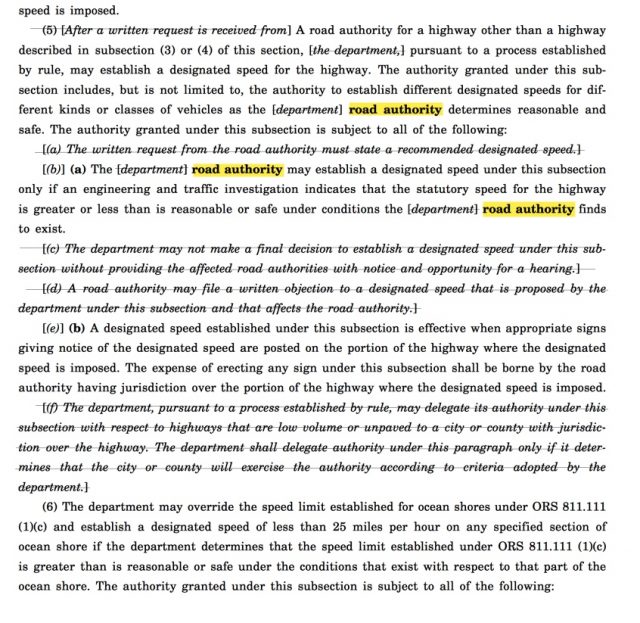
Small and simple changes that could make a world of difference in road safety.
By changing “the department” (which refers to ODOT) to “road authority” and removing several procedural steps, the bill would significantly streamline the process by which cities and counties would be able to alter speed limits.
If the bill passes, local agencies would not have to send a written request to ODOT and they could conduct their own engineering analyses, instead of having to wait and rely on the state.
It’s very early in the session and this bill is sure to spark some debate in committee. Stay tuned for more coverage.
*Representative Rob Nosse: 503-986-1442, Rep.RobNosse@state.or.us
— Jonathan Maus: (503) 706-8804, @jonathan_maus on Twitter and jonathan@bikeportland.org
BikePortland is supported by the community (that means you!). Please become a subscriber or make a donation today.



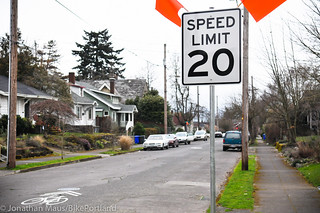
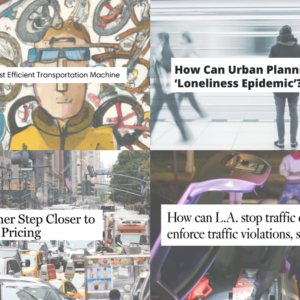

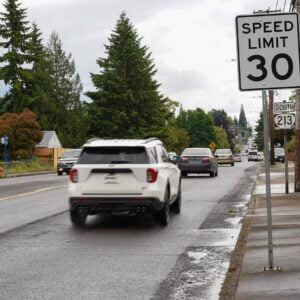
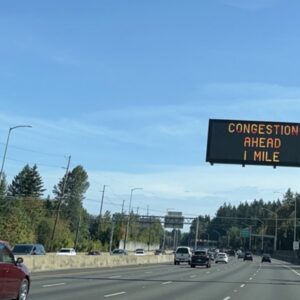
Thanks for reading.
BikePortland has served this community with independent community journalism since 2005. We rely on subscriptions from readers like you to survive. Your financial support is vital in keeping this valuable resource alive and well.
Please subscribe today to strengthen and expand our work.
Please call your representative. If you live in Nosse’s district like I do, then thank the staffer for the representative’s advocacy on House Bill 2682. If you live elsewhere, ask your representative whether they will support House Bill 2682 (make it a question and try to get a response now or in a followup email/call).
You can find your representative here:
https://www.oregonlegislature.gov/findyourlegislator/leg-districts.html
It will have to pass the state senate also, so it may make sense to put this issue on your senator’s radar.
Yes, please take action everyone. It makes absolutely no sense that a state agency, remote from our neighborhoods, should determine our local speed limits.
The way I read this, if a city finds that the 85% speeds on a given road already exceed the posted speed limit, then they may raise the limit. While this bill may good for residents in cities like Portland that want to lower limits, it will be really bad for residents in pretty much everywhere else in Oregon. I recommend “kill the bill!”
“The way I read this, if a city finds that the 85% speeds on a given road already exceed the posted speed limit, then they may raise the limit. …” hampsten
Tell us more about why you feel speed limits could be raised from existing posted speed limits using the 85% formula.
I know just a little about the 85% formula, but not that it would necessarily be part of the conditions made to a local road authority using the provisions of this proposed bill if it became law…by which it would be permitted to change existing posted speed limits.
If this bill were to become law, would the 85 become part of the “…process established by rule…”, by which the state would oblige cities to use to set speed limits on its streets? I guess not many people think about the 85% formula actually being used to raise posted speed limits.
If that question doesn’t turn out to be stumbling block for it to proceed, this bill proposal sounds good. Right now, out in Beaverton, there is a section of Baseline Rd for which the city traffic commission has decided, partly on community request, to apply for a reduction in the posted speed limit on that street from 40 to 35.
There’s some feeling that an even lower mph speed limit may be better, but because of the 85, and the requirement from ODOT to review and approve the proposed reduction before it can happen, the city feels it’s only chance of getting a reduction is if it asks for just 5mph less than current posted. Because of ODOT’s backlog in applications, the timeline for that reduction process could take up to a year. Making this bill a law, could help people confine motor vehicle speeds in their neighborhoods, to speeds that support, rather than detract from neighborhood livability.
I agree, the 85% rule is one of many excuses cities and state DOTs justify raising limits.
However, you are missing my point, by a long shot. The bill as now written not only allows cities to reduce speeds on city streets, as PBOT wants, but also to raise speeds, as many other communities feel constant pressure to do, from both their driving residents and by the FHWA, to reduce automobile commute times. Passing the law will allow communities to sidestep ODOT oversight, such as it is, to raise local speed limits, directly leading to more hardship for pedestrians and likely leading to more pedestrian and driver deaths statewide. What may be good for Portland and Eugene may be terrible for the poor non-driving residents of the rest of the state.
Yeah, the way I read this it seems to give more leeway for Washington County to further raise speeds.
“…The bill as now written not only allows cities to reduce speeds on city streets, as PBOT wants, but also to raise speeds, as many other communities feel constant pressure to do, from both their driving residents and by the FHWA, to reduce automobile commute times. Passing the law will allow communities to sidestep ODOT oversight, such as it is, to raise local speed limits, directly leading to more hardship for pedestrians and likely leading to more pedestrian and driver deaths statewide. …” david hampsten
Show us how you feel this bill, were it to become law as now written (lots of review in committees and on the floor of house and senate, before it becomes law.), would as you say, allow cities to use it to raise speed limits.
If you feel the bill’s language would undesirably allow cities to raise speed limits on streets that should not have higher speed limits than currently existing, you could propose a condition to be written into the bill to prohibit that action without authorization of a higher transportation dept authority…city’s request for a higher speed limit perhaps meaning, back to ODOT for the timeline that dept operates on.
The bill does not do that at all. Existing law does. The bill does not change that part of existing law. Killing the bill will not change the 85% rule.
Local control is better than no control.
Perfect shouldn’t be the enemy of good.
You think residents of Portland, the by-far largest city in Oregon, should pass up the power to lower speed limits on our streets because some hypothetical small town elsewhere in Oregon might do the opposite? I’d wager the constabulary of that hypothetical town isn’t enforcing the existing speed limit anyway.
I’d love to take away the common excuse given by our local traffic engineers that they can’t change lower the speed limit because of ODOT. Making it a local decision allows those of us in smaller cities to hold our city staff’s feet to the fire, indirectly through our elected officials, which may make it easier for them to lower speed limits than to keep being harassed every time they come to work or attend a meeting.
Good bill. We’ll still have a long way to go even if it passes (enforcement, undoing 85th percentile idiocy, education, etc) but a step forward is always to be applauded, imo.
None of this makes one bit of difference if there is no enforcement.
Bingo! This is the most astute comment I have read today.
I live on the N Concord Ave bike boulevard/neighborhood greenway. Very few motor vehicle operators drive 20 mph or less. I assume this is also true on other bike boulevards/neighborhood greenways in the City.
If you are not going to have the resources to enforce these laws, including using cell phones while operating motor vehicles, full stops at stop signs & requiring chains on all motor vehicles during the recent snowpocalypse, quit wasting the time & effort in instituting them. It is a total joke & is getting very old.
There’s always the stop sign enforcement action in Ladd’s Addition to fall back on. That demonstrates that the Traffic Division takes its responsibilities seriously.
The bill as law makes a lot of sense on streets where there is enforcement, and on a lot of streets, there is. Got to start somewhere, and that somewhere, is telling people straight up with a posted speed limit, what the speed limit is.
Once a good speed limit for a given street is set, then the work to enforce the speed limit can begin. Streets that already have the speed limit but that aren’t getting the enforcement to back it up, is a separate issue. After the speed limit, lacking compliance, can possibly come speed reader boards, speed camera vans, and speed bumps.
People on a street posted for 40mph, that should be posted for 25mph, don’t even have that starting point.
124th, a county neighborhood street near where I live, is posted for 25mph. Some people want to drive a lot faster, because the street is located in an area that makes the street tempting to use for a cut through. Despite being a modest income neighborhood, it has an active HOA, which I believe had something to do with the street, over time, acquiring traffic calming islands and speed bumps.
On-street parking further helps calm traffic, because the street really only is wide enough for one car to pass between a car parked on both sides of the street…two can pass each other, but it’s kind of tight for comfort. The result of all these measures together, is that mph speed on this street infrequently exceeds 25 mph, and often is 20 or 15, even during low traffic times of the day and night.
Who would enforce the laws? I hardly ever see patrol cars anymore. Sure, this is just my anecdotal evidence, but I personally see maybe one patrol car a month in the metro area.
I see them all the time…, parked outside the local Starbucks.
Thank God. Starbucks is a hotbed of crime.
See my comment, last paragraph, here:
http://bikeportland.org/2017/01/12/this-simple-bill-will-make-it-easier-for-cities-across-oregon-to-lower-speed-limits-213193#comment-6762440
I’m not sure why you’re not seeing patrol cars. You tell us why you think you’re not seeing them, and also, some ideas you might want to share about how to have speed limits enforced within the abilities of the police dept to do that with the resources it has available to it.
I have no idea why I don’t see them. Maybe there aren’t enough. Maybe they are deployed elsewhere. I’ve lived other places where patrol cars are much more prevalent.
I think you’re not seeing cops patrolling for speeding, because the officers are being assigned to higher priority problems. We see more use of speed reader boards, photo radar vans and red light cameras, because it costs less money to use those means to reduce excessive speeds.
First step though, I think is to get the message clear to road users through the use of signs, exactly what the speed limit is, and let it be known through word of mouth and public relations safety campaigns, what the latitude on excessive speeding is. Personally, I think 5mph over is reasonable, and anything over, even 1mph over or a fraction thereof, is a citation…no if’s, and’s, or; no more of this 11mph that’s rumored to be the current latitude give on speeding before citation.
Members of communities like Beaverton, where I live, have to some extent I think, unwittingly allowed increases in traffic and excessive use of motor vehicles for travel, to gradually degrade neighborhood livability and corresponding functionality of the streets the neighborhoods have been able to offer residents and visitors.
I’m hoping more people will start to think this issue through, and begin speak more strongly in favor preserving or restoring as need be, the livability of their neighborhoods in part by better management of street use.
None of those technology solutions address drunk driving, tailgating, failure to signal, failure to yield, aggressive driving, the basic speed law, unsafe passing, distracted driving, puffing on bongs resting on the steering wheel, expired tags, driving the wrong way (Side note: we’ve had multiple deaths on Hwy 26 recently where people drove the wrong way onto the offramp and then proceeded the wrong way on Hwy 26. I saw someone just last week who drove head-on into someone exiting the highway on the Cornell off-ramp. What is going on here?) or any other number of moving violations that have nothing to do with the posted speed limit.
Sure, countering of all of those things would be helped by patrols…but the discussion is I believe, about encouraging people traveling in their motor vehicles, to stay reasonably within posted speed limits.
Which works, in the very rare locations where those things are used. What about everywhere else?
“…What about everywhere else?” dan a
What do you mean? Not everywhere other than where patrols, speed reader boards and red light cameras, are being used to keep motor vehicle speeds within posted speed limits…are there problems with congestion and excessive speeds. It seems to me that certain routes, and streets used as back routes/cut-throughs to those routes, are where problems with speeding occurs.
Starting with the little stuff seems like a great idea to me, even though not all areas having problems are able to receive attention.
Speeding is a problem pretty much everywhere. Speeding is certainly a problem in Beaverton. As far as I know, we have ONE speed camera, on B-H. Saying that not all areas are receiving attention is an understatement.
FWIW, I do see Washington County patrol cars around. I hardly ever see PPD cars around, and I spend a fair bit of time in Portland. We talk a lot about vulnerable road users here, but I’m finding that even driving has become rather scary at times. I see an awful lot of reckless and aggressive driving these days, and it’s disconcerting to know that the chance of anybody being caught swerving in & out of traffic or intimidating other drivers is practically nil.
Yep! Until I see somebody getting a ticket for driving 21mph in the newly-reduced 20 zone greenway I commute in–or at least see a single police car ready to do so–I can’t get too excited about a few signs getting put up.
I’d love 20, but 15 makes it more quiet.
The story is inaccurate.
15 mph is already a statutory speed limit permitted on a ‘narrow residential roadway’, call them NRRs.
The recent change in law is also poorly described. The law, as written, permits a reduction in the statutory speed limit by 5 mph without ODOT permission when certain conditions are met.
Combined with the NRR statutory speed, the actual possible lowest posted speed is 10 mph on a narrow residential roadway.
A ‘narrow’ roadway is anything less than 18 feet for two directions of travel.
A ‘roadway’ is the portion of the street intended for ‘travel’.
Every street in Portland 34 feet wide or less, with parking on both sides, (34-16 = 18′) qualifies under these definitions.
If you wanted to further clarify the parking lane as not for travel, marking it as such, changing the space to a different material (SE Rex), or adding curb extensions should be sufficient.
So everyone can more easily read them, post links to text of the statute for the NRR provision, and the 5mph speed limit reduction law.
What you’re suggesting, may have some validity, but if it really does, and thorough the use of the provisions of this statute, Portland could autonomously reduce speed limits on streets having “…less than 18 feet for two directions of travel. …”, not including area of the street used for parking, it seems like the city would just gone ahead and done so.
Yes.
Why was the original law written? Was it because cities were setting speeds willy-nilly, creating confusion, or were they setting speed traps for outsiders, or was it the auto lobby, or ?? Genuinely curious.
I definitely support local residents having a strong say in what speeds are allowable.
The cursed “speed trap”, bane of every lead-footed driver’s existence. How dare these small towns try to keep their citizens safe! I have places to be!
speed traps aren’t about having a lead foot, they’re about hard to notice speed limit signs in areas where the road design doesn’t seem to change…
Like I-5 through Maywood park.
Heaven forbid people driving automobiles have to “notice” things..
So what’s wrong with speed traps if it keeps drivers aware of their speed?
They sound like a win-win to me–raise money for small towns and keeps speed down.
I think the legislation might be good. I support it. It’s *possible* that some road authorities could raise speed limits, but, then, that would be up to the people living in those communities, ultimately. I don’t think it would be thunderdome, out there, and I do think Portland would lower speeds on a lot of streets that could use it.
Oh, and I voted for Rob Nosse twice. I hope you’re not jealous that he’s my Representative. 🙂
I fully support this bill as well as lowering speed limits city-wide, but let’s not kid ourselves that doing so will have much of an impact on safety. Sure, some drivers will slow down, but the vast majority will continue to drive at a speed that feel safe to them – which in most of our over-engineered streets in East Portland is far higher than whatever PBOT would likely lower the speed limit to. Lowering speed limits is a cop out so that the city can get away without re-enginerring streets for lower speeds.
True, but all it takes is a few of us to drive slow to force the others to do the same. I have noticed a slowing of traffic on SE Hawthorne since the limit change. Not everyone, of course, but the vibe has definitely changed for the better.
on a one lane road, it only takes a few to keep speeds down. Road diets!
Yep, I’d much prefer this solution than simple lowering speed limits and calling it a day.
Lets do both.
“…Sure, some drivers will slow down, but the vast majority will continue to drive at a speed that feel safe to them…” adam h
I think that’s an unsupported assumption. What is the posted speed limit on the streets to which you refer, and how many mph higher than that speed do you venture to guess people are commonly driving on these streets?
If streets are not being posted with speed limits that correspond with levels of safety and functionality that residents and hopefully the city want from their streets, that’s a first and major obstacle to bringing motor vehicle speeds traveled within reasonable limits.
The logic you’re presenting seems to be, ‘They’re going to go faster anyway, so why even try any speed reduction measures besides re-engineering the streets where common excessive speeding is occurring?’.
Not specifying what you mean by “…re-enginerring streets for lower speeds.”, leaves people unnecessarily having to guess what you have in mind. What you may be implying, sounds like things that would be far more costly and longer term to implementation projects than would be simply switching out existing signs for a lower posted speed limit. There may be neighborhoods that need changes to occur ASAP, or ‘now’, rather than two or three years down the road.
The first, but not necessarily the only…easy and affordable excessive speed reduction measure to try, is to make certain streets are clearly and conspicuously posted for speed limits that are compatible with the safety and functionality needs of the neighborhood and the city for those streets. If that simple measure doesn’t get the desired results, then is the time to try stronger, more costly, longer term to implement measures.
Yes, but..cops will find it better to pull someone over doing 10 over than 5 over.
I want to thank Rob Nosse for listening to his constituents. Traffic safety advocacy can get results.
To anyone lamenting “speed traps”, I made a decision after riding regularly to drive much, much slower. Like, 5 to 10 under the speed limit sometimes depending on the “limit”. Remember, this is the limit, not the min.
Since that time, haven’t even come close to being pulled over despite the speed”traps”. I just drive on by the cop as he looks at me doing 10 under.
So, power to the people. The state should have zero control over local roads. If locals want 1mph, so be it.
“To anyone lamenting “speed traps”, I made a decision after riding regularly to drive much, much slower. Like, 5 to 10 under the speed limit sometimes depending on the “limit”. …” mark smith
What you said calls to my mind, Jenkins Rd between Murray and Cedar Hills Blvd: …past tektronix, lots of housing, and to the mall. Posted for 35mph. Do people driving that road really need that high a posted speed? Is that high a speed really beneficial to them and people living and working in the area? In the evenings after rush hour…maybe 8pm and later, there’s not a lot of traffic on the road. 25mph seems to work just fine for this short distance, and that’s generally the speed I travel.
Another one I drive regularly is Cornell between Bethany and 173rd, which I just realized is posted for 45. I’ve been going 30-35mph based on the ‘feel’ of the road, and would be okay with it posted lower. 45 is way too fast, and I’m sure other drivers are going 50 or 55 there.
This is potentially huge and a very good thing.
Local power to lower speed limits means more ability to experiment, which is what we need to be able to reach vision zero.
There are a lot of potential fixes which would allow motor vehicle traffic to slowly crawl through at a much safer 15 mph — except current state law doesn’t allow that.
If you want to track the bill or learn more, you can do so here:
https://olis.leg.state.or.us/liz/2017R1/Measures/Overview/HB2682
I called my State Senator (Michael Dembrow, District 23 represent!) and spoke to a very friendly staffer who was not yet familiar with the legislation. She was very interested, said she would look into it, and also said it sounded like something Senator Dembrow would support as he’s a bike commuter himself. I let her know I read about it on Bike Portland and she said she was very familiar with the web site. All good news.
Find and call your State Senator. It’ll make your day!
https://www.oregonlegislature.gov/findyourlegislator/leg-districts.html